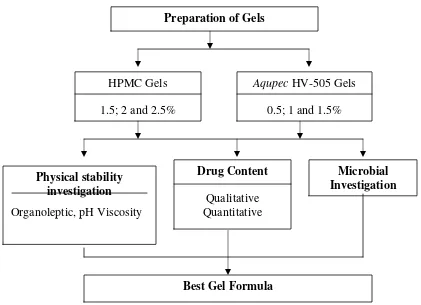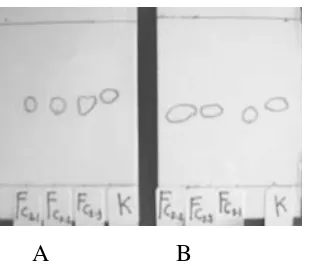STUDY OF PIROXICAM GEL STABILITY USING HPMC AND ACUPEC HV-505 BASES
Anis Yohana Chaerunisaa, Boesro Soebagio, Marline Abdassah Faculty of Pharmacy, Padjadjaran University, Bandung
ABSTRACT
An investigation on piroxicam gel formulation using HPMC base (1.5, 2.5 and 5%) and other formula using Aqupec HV-505 bases (0.5, 1 and 1.5%, respectively, had been carried out to find out the best formula. The stability testing was conducted on organoleptic, pH, viscosity and, consistency for 28 days of storage. The result showed that the formula with 1% Aqupec HV-505 bases (FC2) was the best one. Further
investigation was conducted with variation of of Piroxicam concentrations to know it’s influence to gel stability. The additional investigation conducted to the best formula were microbiology, qualitative and quantitative stability testing using Thin-Layer Chromatography (TLC) and High Performance Liquid Chromatography (HPLC) for 56 days of storage. The result showed that the best gel formula was that with 1% Aqupec HV-505 with 0,5% piroxicam (FC2.2).
Keywords: Piroxicam, Gel, HPMC, Aqupec HV-505.
INTRODUCTION
Piroxicam is one of the most potent Non Steroidal Antiinflammatory agents that also have antipyretic activity. Piroxicam is well absorbed following oral administration; however, its used has been limited by a number of side effect, including bleeding and ulceration. Transdermal adnministration of piroxicam can overcome this side effect, and higher local concentration can be maintained at the target site, which is desirable for the antiinflammatory agent (Banakar, 1992; Panchagnula, 1997; Doliwa, 2001). Transdermal drug delivery system has the additional advantages of avoiding hepatic first-pass metabolism and providing the controlled delivery of the drug for an extended period (Dallas, 1987).
formulation, the effects of concentration of gelling agent, the effect of concentration of the drug, the pH and viscosity of the gel and drug content were evaluated.
METHODOLOGY
Table 1. Formula of Piroxicam Gels with Various Base FORMULAS *)
INGREDIENTS
FB1 FB2 FB3 FC1 FC2 FC3
HPMC (%) Aqupec HV-505 (%)
Piroxicam (%) TEA (%) Propylenglycol (%) Methyl Paraben (%) Propyl Paraben (%) Ethyl Acetat (%)
Aquadest ad 1.5 - 0.5 3 20 0.2 0.05 5 100 2 - 0.5 3 20 0.2 0.05 5 100 2.5 - 0.5 3 20 0.2 0.05 5 100 - 0.5 0.5 3 20 0.2 0.05 5 100 - 1 0.5 3 20 0.2 0.05 5 100 - 1.5 0,.5 3 20 0.2 0.05 5 100
*) FB1 = Piroxicam gel with HPMC 1.5%, FB2 = Piroxicam gel with HPMC 2%, FB3 = Piroxicam gel with HPMC 2.5%, FC1 = Piroxicam gel with Aqupec HV-505 0.5%, FC2 = Piroxicam gel with Aqupec HV-505 1%, FC3 = Piroxicam gel with Aqupec HV-505 1.5%
Preparation of Gels
HPMC Gels
1.5; 2 and 2.5%
Aqupec HV-505 Gels
0.5; 1 and 1.5%
Physical stability investigation
Organoleptic, pH Viscosity
Drug Content
Qualitative Quantitative
Microbial Investigation
RESULTS AN DISCUSSION Physical Stability of Gel Base
Based on organoleptic investigation, both HPMC and Aqupec HV 505 gel were pale yellow, clear, transparent and well spreadable. Ideal pH for piroxicam gel was 6-8. HPMC gels which fulfilled the pH requirements was only FB1 while others had too high pH value. The pH of gel base exhibited in Figure 1 while Figure 2 showed the viscosity of gel base during storage periods.
pH of Piroxicam Gels with Various Base
7.6 7.8 8 8.2 8.4
0 10 20 30
Days
p
H
FB1 FB2 FB3 FC1 FC2 FC3
Figure 1. pH of Piroxicam Gel with Various Base
Viscosity of Piroxicam Gels with Various Base
0 100 200 300 400
0 10 20 30
Days
V
is
c
o
s
it
y
(
d
P
a
s
)
FB1 FB2 FB3 FC1 FC2 FC3
Figure 2. Viscosity of Piroxicam Gel with Various Base
significant decrease on gel viscosity. The pH of Piroxicam gels in Aqupec HV-505 Base during 56 days of storage time exhibited in Figure 3, while Figure 4 showed the viscosity of gels during storage periods.
pH of Piroxicam Gels in Aqupec HV-505 Base
7.4 7.6 7.8 8 8.2
0 20 40 60
Days
p
H FC2.0
FC2.1 FC2.2 FC2.3
Figure 3. pH of Piroxicam Gels in Aqupec HV-505 Base during storage time (FC2.0 = 1% Aqupec HV-505 Gel base without Piroxicam, FC2.1 = 1% Aqupec HV-505 Gel base with 0.25% Piroxicam, FC2.2 = 1% Aqupec HV-505 Gel base with 0.5% Piroxicam, FC2.3= 1% Aqupec HV-505 Gel base with 1% Piroxicam )
Viscosity of Piroxicam Gels in Aqupec HV-505 Base
0 200 400
0 20 40 60
Days
V
is
c
o
s
it
y
(d
P
a
s
)
FC2.0 FC2.1 FC2.2 FC2.3
Qualitative and Quantitative determination of piroxicam in Gels
A B
Figure 5. TLC Chromatograms of Piroxicam Gels at first day of formulation (A) and after 56 days of storage (B) (FC2.1 = 1% Aqupec HV-505 Gel base with 0.25% Piroxicam, FC2.2 = 1% Aqupec HV-505 Gel base with 0.5% Piroxicam, FC2.3= 1% Aqupec HV-505 Gel base with 1% Piroxicam, K = Piroxicam )
Table 2 . Rf of Piroxicam in Gels
Rf (Room Temp.) at days of:
Formula 1st 56th
Piroxicam control Piroxicam FC2.1 Piroxicam FC2.2 Piroxicam FC2.3
0.5393 0.5169 0.5169 0.5169
0.4719 0.4494 0.4719 0.4494
Table 3. Piroxicam Content in Gels
Piroxicam content (%) at days of: Formula
1 56
FC2.0 0 0
FC2.1 120.55 113.51
FC2.2 115.23 114.47
FC2.3 107.86 115.45
Microbial Investigation
It was found that no bacterial growth happened after 14 days of investigation which can be concluded that the preservative are effectively worked in the gels.
CONCLUSION
Among all the formulation, the 0.5% Piroxicam in 1% Aqupect-HV 505 gave the highest stability and quite preferable. The study support the evidence that stability was exhibited in physical, qualitative, quantitative and microbiological characteristic. This can serve as the basis for developing topical formulation of piroxicam with the best stability.
AKCNOWLDGEMENTS
The authors thank to A2 Competition Grant Faculty of Pharmacy, Padjadajaran University for funding this research. We also thank Anggi Restiasari and Mutakin for their excellent technical assistance in doing this research
REFERENCES
1. Banakar, V. 1992. Transdermal Drug Product Development. Basel : Technomic Pub. p 50-72.
2. British Pharmacopoeia Commission. 1999. British Pharmacopoeia. Volume I. London: The Stationary Office. p1153-1154.
3. Dallas, P. 1987. “Medicament Release from Oinment Bases : IV. Piroxicam : In-Vitro Release and In-Vivo Absorption in Rabbits”. Drug Development and Industrial Pharmacy 13(8). New York : Marcel Dekker. p 1371-1397.
4. Doliwa, A. 2001. “Transdermal Iontophoresis and Skin Retention of Piroxicam from Gels Containing Piroxicam : Hydroxypropy cyclodextrin Complexes”. Drug Development and Industrial Pharmacy 27(9). New York : Marcel Dekker. p 751-758.
6. Panchagnula, R. 1997. “ Transdermal Delivery of Drugs”. Indian Journal of Pharmacology 29. Patiala : Indian Pharmacological Society. p 140-156.
7. Reynolds, J. E. F. 1993. Martindale, The Extra Pharmacopoeia 30(2). London : The Pharmaceutical Press. p 80-81, 1472-1474.



